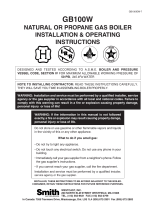
3DUW1XPEHU
3
5ead tKLs paJe Àrst
Failure to adhere to the guidelines below can result in severe personal injury, death or substantial property damage.
When servicing boiler —
To avoid electric shock, disconnect all
electrical supplies to the boiler before
performing maintenance.
To avoid severe burns, allow boiler to cool
before performing maintenance.
This boiler contains ceramic fiber and
fiberglass materials. Refer to the WARN-
ING and instructions on page 33.
Boiler operation —
Do not block flow of combustion or ven-
tilation air to boiler.
Should overheating occur or gas supply
fail to shut off, do not turn off or discon-
nect electrical supply to pump. Instead,
shut off the gas supply at a location ex-
ternal to the appliance.
Combustion air —
DO NOT install combustion air intake
where there is a risk of combustion air
contamination.
Boiler water —
Do not use petroleum-based cleaning
or sealing compounds in boiler system.
Gaskets and seals in the system may be
damaged. This can result in substantial
property damage.
DO NOT use “ homemade cures ” or “
boiler patent medicines”. Serious dam-
age to boiler, personnel and/or property
may result.
Continual fresh make-up water will re-
duce boiler life. Mineral buildup in eat
exchanger reduces heat transfer, overheats
the aluminum heat exchanger, and causes
failure. Addition of oxygen carried in by
make-up water can cause internal cor-
rosion. Leaks in boiler or piping must
be repaired at once to prevent make-up
water. Use this boiler ONLY in a closed-
loop system.
Do not add cold water to a hot boiler.
Thermal shock can cause sections to crack.
Freeze protection fluids —
NEVER use automotive or standard
glycol antifreeze. Use only freeze-
protection fluids made for hydronic
systems. Follow all guidelines given
by the antifreeze manufacturer.
Thoroughly clean and flush any re-
placement boiler system that has used
glycol before installing the new boiler
Frozen Water Damage
Hazard
Residences or buildings that are unat-
tended in severely cold weather, boiler
system components failures, power out-
ages, or other electrical system failures
could result in frozen plumbing and water
damage in a matter of hours. For your
protection, take preventative actions such
as having a security system installed that
operates during power outages, senses low
temperature, and initiates an effective ac-
tion. Consult with your boiler contractor
or a home security agency.
If any part of a boiler, burner or its controls has
been sprayed with or submerged under water,
either partially or fully, DO NOT attempt to op-
erate the boiler until the boiler has been either
replaced or completely repaired, inspected, and
you are sure that the boiler and all components
are in good condition and fully reliable.
Otherwise, by operating this boiler, you will
cause a fire or explosion hazard, and an electrical
shock hazard, leading to serious injury, death, or
substantial property damage. See the instructions
at right.
3ALTWATER $AMAGE — The exposure of boiler components to
saltwater can have both immediate and long-term effects. While the
immediate effects of saltwater damage are similar to those of fresh-
water (shorting out of electrical components, washing out of critical
lubricants, etc.), the salt and other contaminants left behind can lead
to longer term issues after the water is gone due to the conductive
and corrosive nature of the salt residue. Therefore, Weil-McLain
equipment contaminated with saltwater or polluted water will no
longer be covered under warranty and should be replaced.
%LECTRICAL $AMAGE — If any ELECTRICAL COMPONENT or WIRING
came into contact with water, or was suspected to have come into
contact with water, replace the boiler with a new Weil-McLain boiler.
)NSTALLER— Read all instructions, including this
manual and all other information shipped with the
boiler, before installing. Perform steps in the order
given.
5SER— This manual is for use only by a qualified
heating installer/service technician. Refer to User’s
Information Manual for your reference.
5SER — Have this boiler serviced/inspected by a
qualified service technician, at least annually.
Failure to comply with the above could result in severe
personal injury, death or substantial property damage.
Improper installation, adjustment, alteration, ser-
vice or maintenance can cause property damage,
personal injury, exposure to hazardous materials,
or loss of life. Installation and service must be
performed by a qualified installer, service agency
or the gas supplier who must read and follow the
supplied instructions before installing, servicing or
removing this boiler. This boiler contains possibly
carcinogenic, to humans.
Write in the CP number in the space provided on the
)NSTALLATIONAND3ERVICE#ERTIlCATE on page 27, if
not already shown.
When calling or writing about the boiler— Please
have the boiler model number from the boiler rating
label and the CP number from the boiler jacket.
Consider piping and installation when determining
boiler location.
Any claims for damage or shortage in shipment
must be filed immediately against the transportation
company by the consignee.
EG and EGH boilers for tankless or storage heater
application are available only on special order as
factory-installed optional equipment. Tankless
heater cannot be added to standard block assem-
bly. Block assembly must be ordered with heater
openings. Standard boilers cannot be adapted for
heater use.
EG
&
PEG SERIES 5
s
EGH SERIES 5 GAS-FIRED BOILERS — BOILER MANUAL




















